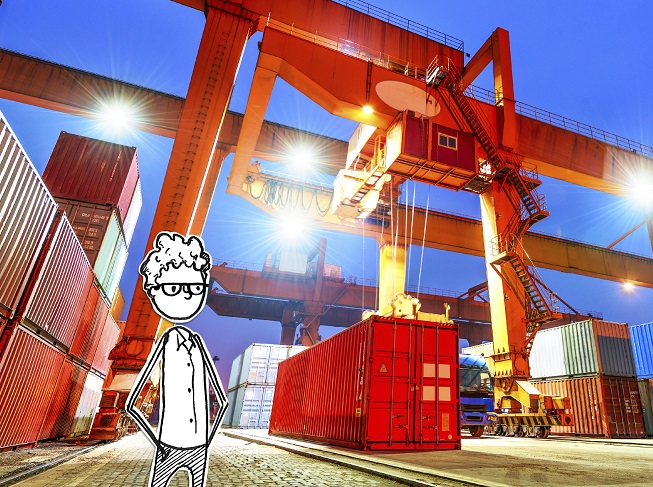- The first step consists of deciding on the type of suitable container, depending on the features of the product to be shipped
- The second step consists of loading the cargo into the container, which must be carefully examined
Exports
Tips for loading export products into a freight container
Most products travel in containers of uniform size and shape. Choosing an adequate container, reviewing its condition and securing the merchandise are some tips for safely shipping goods to their destination.

HIGHLIGHTS
If you visit any large port in the world today it will be very difficult for you to tell at a glance what products are being shipped: you will only see large and repetitive rectangular containers stacked on top of each other.
This is because international commercial transportation is vastly “containerized.” What does this mean? Well, professor Rama Gopal, from the Bhopal Management Institute of India, explains that “containerization is the practice of transporting goods in containers of uniform size and shape. Almost anything can be stored in a container, but they are particularly useful for transporting manufactured goods.”
Containerization entails an enormous advantage but it also implies a huge challenge for exporters. The great advantage is that it has drastically reduced logistics costs: on the one hand, fewer workers are needed to load and unload crates and sacks to and from ships, and on the other hand, less time is required at port, due to the speed with which cargo is handled.
However, this practice also implies a technical challenge. Captain James McNamara, former President of the United States National Cargo Bureau explains that “the key person is the shipper and/or the person responsible for loading (packing/stuffing) the container.” In other words, while before the responsibility laid with the stevedores, now the exporters themselves must know how to condition their products for shipment.
Decisions regarding how to load a container can be divided into two steps: first, the type of container that is required and second, how to load the merchandise itself.
First step: deciding on container type
This decision depends on the characteristics of the product to be shipped. Professor Gopal explains that there are six types of containers:
- General purpose containers: “these are the most common, and are the ones with which most people are familiar. Each container is fully closed and has full width doors at one end for access. Both liquid and solid substances can be loaded in these containers.”
- Refrigerated containers: are designed to carry products that require refrigeration.
- Dry bulk containers: “these are built especially for the carriage of dry powders and granular substances.”
- Open top/open sided containers: these can be open on the top or on the sides for the carriage of heavy or unusual size cargo.
- Liquid cargo containers: these are ideal for bulk liquids (wine, oils, detergents, etc.)
- Hanger containers: they are used for the shipment of garments on hangers.
Second step: how to load the container
Once a decision has been made as to the type of container that will be used, the exporter must address the task of loading the merchandise. Gopal and McNamara offer several tips for this process, which can be divided into three steps.
The first step is to check the container before starting to load. McNamara suggests that the exporter should “examine the physical condition of the container just as if you were buying it: Has it been repaired? If so, does the repair quality restore the original strength and weather-proof integrity?”
Gopal agrees with these recommendations and advises to “check if there are no holes in the container: somebody should get inside the container, close the doors and ensure that no light enters.” Both suggest checking if the container is clean, especially when transporting products that are sensitive to odors, such as food. Finally, Gopal reminds us to check that no placards or labels are left on the container from earlier cargo so as to avoid confusion.
The second step is the loading of the container. Here pre-planning is probably the most relevant point: “It is important to pre-plan the stowage of the cargo in the container – affirms McNamara- The weight should be spread evenly over the entire length and width of the floor of the container.”
Planning is particularly important when transporting goods with different features. In these cases, Gopal recommends not packing wet goods with dry goods, or mixing dusty goods with dust sensitive goods and to not place heavy packages over light ones.
Exporters themselves are responsible for loading their products into the shipping containers
Protruding parts, edges or corners of goods should not be placed with soft goods such as sacks or cardboard boxes; odor emitting goods should not be placed with odor sensitive goods.
Another important point has to do with empty space: if there is free space in the container, certain goods may move during the trip and damage others. “Fill it or secure it,” says Mc McNamara, adding “Use dunnage, block it out. Leave no void spaces or loose packages on top.”
The third step is to check the container once it is loaded. Gopal reminds us of the importance of displaying a packing list in the container at a visible place. Meanwhile, McNamara suggests checking “that package hazard labels and container placards, if required, have been applied.”
Quarantine and other relevant rules and regulations should also be taken into account. Finally, Gopal suggests checking that door handles are sealed and – in case of open top containers- that protruding parts have been properly tied.
BIBLIOGRAPHY
- Gopal, Rama. Export-Import Procedures. Documentation and Logistics. New Age International, New Delhi, 2008.
- McNamara, James. 10 Steps to Load, Stow and Secure a Freight Container. In Journal of Commerce, June 2, 2009.
KEYWORDS


Follow Us